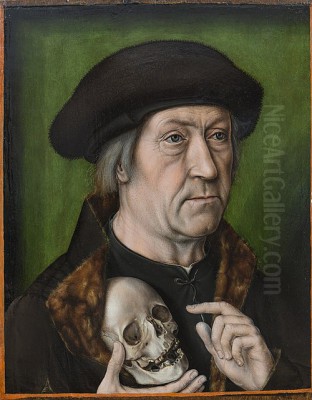
Albrecht Bouts, a significant yet sometimes overshadowed figure in the rich tapestry of Early Netherlandish painting, carved a distinct niche for himself in the bustling artistic center of Leuven during the late 15th and early 16th centuries. Born into an artistic dynasty, he not only inherited the mantle of his renowned father but also steered the family workshop towards new avenues of devotional art, leaving behind a legacy of intensely spiritual and meticulously crafted works. His life and career offer a fascinating glimpse into the artistic practices, religious sentiments, and burgeoning art market of a transformative period in European history.
Early Life and the Patriarch's Shadow
The precise birth year of Albrecht Bouts is generally accepted by scholars to be around 1451 or 1452, though some earlier accounts suggested a date closer to 1455 or even 1460. He was born in Leuven, a prominent university city in the Duchy of Brabant, which was then part of the Burgundian Netherlands. His father was the illustrious Dieric Bouts the Elder (c. 1415–1475), one of the leading painters of his generation, celebrated for his profound emotional depth, refined technique, and innovative approach to perspective and landscape. Dieric Bouts the Elder, himself likely influenced by masters such as Jan van Eyck and Rogier van der Weyden, established a thriving workshop in Leuven, becoming the city's official painter in 1472.
Albrecht, along with his elder brother Dieric Bouts the Younger (c. 1448–1491), was naturally apprenticed in their father's studio. Here, they would have learned the intricate processes of panel preparation, pigment grinding, oil painting techniques, and the prevailing iconographic conventions. The elder Bouts's style, characterized by its serene yet poignant figures, detailed naturalism, and subtle use of light, undoubtedly formed the bedrock of Albrecht's artistic education. In 1473, a municipal record notes Dieric Bouts the Elder acknowledging the independent status of his two sons within the workshop, suggesting they had reached a level of proficiency.
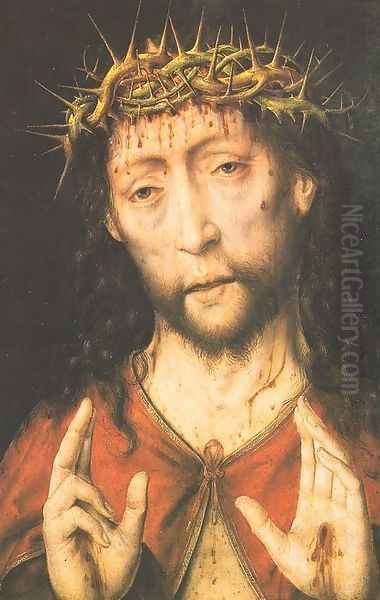
Upon Dieric Bouts the Elder's death in 1475, the workshop and its considerable reputation passed to his sons. Albrecht was still relatively young, in his early twenties, but the groundwork laid by his father provided a solid foundation. His father's will, also dated 1475, specifically bequeathed his painting tools, unfinished works, and ongoing portrait commissions to both Dieric the Younger and Albrecht, indicating a clear intention for them to continue the family enterprise.
The Bouts Workshop: Continuity and Innovation
Initially, Albrecht and Dieric Bouts the Younger likely collaborated closely. Dieric the Younger seems to have taken on a more prominent role in fulfilling official commissions, perhaps even completing some of their father's unfinished major works, such as the "Justice of Emperor Otto III" panels. The famous Pearl of Brabant Altarpiece (Alte Pinakothek, Munich), a work of exquisite detail and delicate beauty, is often attributed to Dieric Bouts the Younger, or at least to the Bouts workshop during this transitional period, possibly with Albrecht's involvement.
After Dieric the Younger's death in 1491, Albrecht Bouts assumed full control of the workshop. He continued to operate it successfully for nearly six decades, until his own death in 1549. Under his stewardship, the workshop became a prolific producer of religious paintings, catering to a growing demand for devotional images from both ecclesiastical patrons and private individuals. This era saw the rise of the Devotio Moderna, a religious movement emphasizing personal piety and an intimate, empathetic connection with Christ and the saints, which fueled the market for smaller, portable artworks suitable for private contemplation.
Albrecht Bouts proved to be an astute manager and a canny artist who understood the market. While he maintained the high technical standards established by his father, he also adapted the workshop's output. A significant portion of the studio's production involved creating variations and copies of successful compositions by Dieric Bouts the Elder, such as the "Man of Sorrows" or "Virgin and Child" themes. This practice was common at the time and ensured a steady stream of income. However, Albrecht was not merely a copyist. He introduced his own stylistic nuances and developed new compositions that resonated with contemporary devotional trends.
Artistic Style and Influences
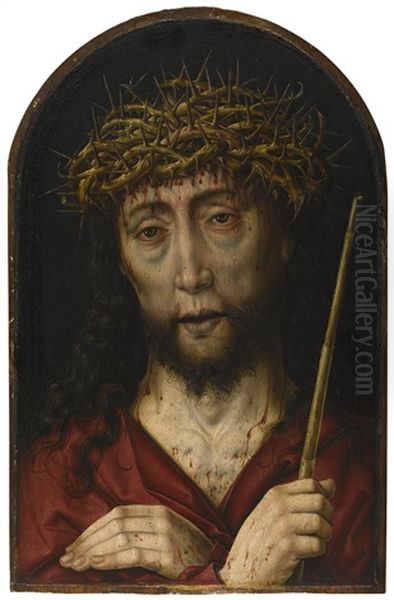
Albrecht Bouts's personal artistic style, while rooted in his father's tradition, evolved over his long career. His early works naturally show a strong adherence to the paternal model. However, by the 1480s, art historians detect the influence of Hugo van der Goes (c. 1430/1440–1482), another towering figure of Early Netherlandish art, known for his monumental figures and intense psychological drama. This influence is seen in a greater emphasis on emotional expression and a certain robustness in figure types in some of Albrecht's works from this period.
Around 1490, perhaps coinciding with his assumption of sole leadership of the workshop, Albrecht's style seems to have consciously reverted to a closer alignment with his father's more restrained and introspective manner. Yet, he infused this with his own distinct characteristics. His paintings often feature strong, sometimes even stark, colors, with a particular fondness for deep blues, greens, and rich reds. He paid meticulous attention to texture, rendering fabrics, flesh, and landscape elements with a high degree of realism. His figures, while often imbued with a quiet sorrow or contemplative piety, can also display a more pronounced, sometimes even exaggerated, emotional intensity compared to his father's work.
A notable feature of Albrecht Bouts's art is his skill in landscape painting, a legacy from his father who was a pioneer in this area. The backgrounds of his paintings often feature detailed and atmospheric landscapes, with winding paths, rocky outcrops, and distant vistas that not only provide a setting but also contribute to the mood of the scene. His compositions are generally well-balanced, though sometimes more crowded or compact than his father's. He often used architectural framing devices or carefully placed figures to guide the viewer's eye.
One of Albrecht's significant innovations was in the realm of small-scale devotional portraits, particularly images of Christ as the "Salvator Mundi" (Savior of the World) or the "Man of Sorrows," and the Virgin Mary as "Mater Dolorosa" (Sorrowful Mother). He developed a formula for these, often presenting the figures in bust-length, against a dark background, sometimes framed within a painted arch or window. These images, produced in considerable numbers by his workshop, were designed to evoke a direct, personal, and empathetic response from the viewer, perfectly aligning with the tenets of the Devotio Moderna. He often paired these images, creating diptychs that encouraged contemplation of Christ's suffering and Mary's compassion.
Key Themes and Iconography
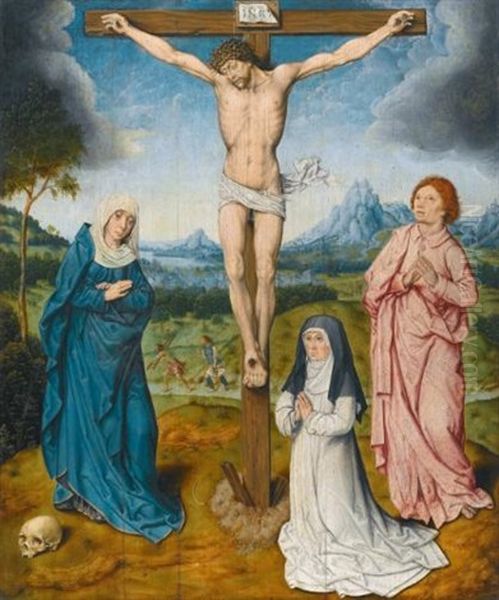
The vast majority of Albrecht Bouts's oeuvre is religious in nature. His workshop specialized in subjects that were popular for private devotion and church altarpieces. Images of Christ were central: depictions of his infancy with the Virgin Mary, scenes from his Passion (such as the "Ecce Homo," "Christ Carrying the Cross," and the "Crucifixion"), and post-Resurrection appearances. The "Man of Sorrows," showcasing Christ crowned with thorns, often weeping, became a signature theme, rendered with palpable pathos.
The Virgin Mary was another key figure, depicted as the loving mother in "Virgin and Child" compositions, or as the grieving mother in "Pietàs" (Lamentations) and "Mater Dolorosa" portraits. Albrecht's portrayals of Mary often emphasize her humanity and her shared suffering, making her an accessible intercessor for the faithful. Saints also featured prominently, including John the Baptist, Jerome, Catherine, and Barbara, often commissioned by patrons with specific devotions.
His approach to these traditional themes was characterized by a desire to heighten the emotional impact. He achieved this through expressive facial features, poignant gestures, and sometimes through the inclusion of symbolic details, like the instruments of the Passion or tear-streaked faces. This focus on affect was a hallmark of late Gothic art in the North, distinguishing it from the more idealized and classical tendencies emerging in the Italian Renaissance with artists like Leonardo da Vinci or Raphael, though both traditions shared a commitment to naturalism.
Representative Masterpieces
While attributing works definitively to Albrecht Bouts himself, as opposed to his workshop, can be challenging, several key pieces are widely accepted as autograph or close to his hand, showcasing his distinct artistic personality.
The _Assumption of the Virgin Triptych_ (c. 1495-1500), now in the Royal Museums of Fine Arts of Belgium, Brussels, is perhaps his most significant and securely attributed large-scale work. The central panel depicts the Virgin Mary being carried heavenward by angels, while the apostles gather around her empty tomb below. The side wings show donor portraits. The triptych is notable for its vibrant, cool-toned palette, particularly the blues and greens, its dynamic composition, and the expressive, individualized faces of the apostles. The landscape is lush and detailed, demonstrating Bouts's skill in this area.
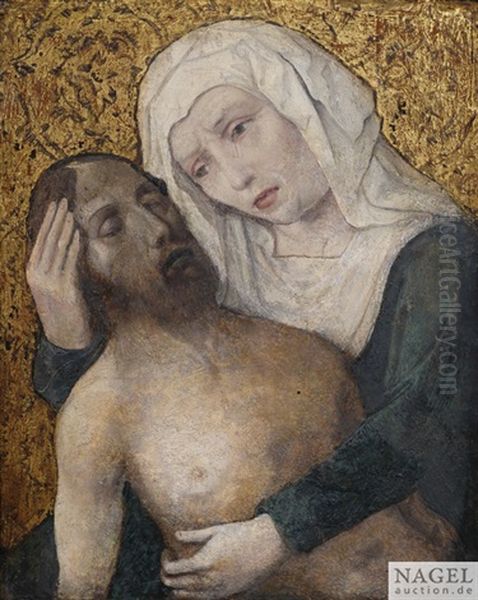
A series of _Christ as the Man of Sorrows_ paintings are closely associated with Albrecht Bouts. One fine example, sometimes titled _The Face of Christ_ (c. 1500), is in the Royal Museum of Fine Arts, Antwerp. This iconic image presents Christ's head and shoulders, crowned with thorns, his face etched with suffering yet imbued with a serene dignity. The meticulous rendering of individual thorns, strands of hair, and tears makes the image intensely immediate and moving. Such works were highly sought after for private prayer.
The _Passion of Christ_ (c. 1491), housed in the Suermondt-Ludwig Museum, Aachen, is another important work. It depicts Christ carrying the cross, surrounded by a throng of figures, showcasing Bouts's ability to handle complex, multi-figure compositions. The emotional intensity of the scene is palpable, with a focus on Christ's suffering and the grief of his followers.
Similarly, the _Lamentation of Christ_ (c. 1517), also in Aachen, portrays the Virgin Mary, St. John, and Mary Magdalene mourning over the dead body of Christ. The raw grief of the figures is powerfully conveyed, typical of Bouts's desire to engage the viewer's empathy. The angularity of the figures and the expressive distortion in their faces contribute to the scene's dramatic impact.
A fascinating work is the _Portrait of a Man (Self-Portrait?)_ (c. 1520-1525), located in the National Museum of Art of Romania, Bucharest. This painting, depicting an elderly man holding a skull—a memento mori (reminder of death)—was re-identified by scholars as a likely self-portrait of Albrecht Bouts in his later years. The introspective gaze and the symbolic skull align with the devotional themes prevalent in his work and offer a personal glimpse of the artist.
Collaborations and Contemporaries
Albrecht Bouts's primary collaboration was undoubtedly within his own family workshop, first with his brother Dieric the Younger, and later with the numerous assistants and apprentices he would have employed. The workshop system of the time involved a master overseeing the production, with varying degrees of participation from other hands depending on the commission's importance and price. This collaborative environment was standard for artists like Hans Memling in Bruges or Gerard David, who succeeded Memling as the leading painter there.
While direct documented collaborations with artists outside his workshop are scarce, Albrecht Bouts operated within a vibrant artistic network. Leuven, with its university, attracted scholars and artists. He would have been aware of developments in other Netherlandish centers like Bruges, Ghent, Brussels, and Antwerp, the latter rapidly rising as a major artistic and commercial hub during Albrecht's lifetime, with painters like Quentin Matsys (or Massys), who himself had roots in Leuven, establishing prominent careers.
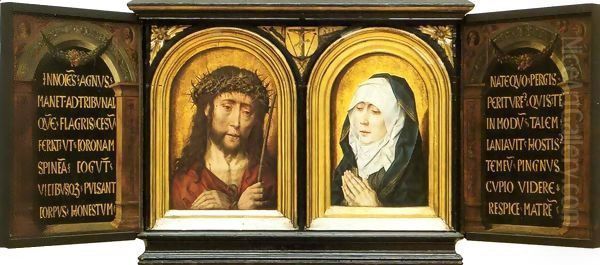
His art shows an awareness of trends set by earlier masters like Jan van Eyck and Rogier van der Weyden (his father's likely teacher), and contemporaries like Hugo van der Goes. The demand for specific types of devotional imagery meant that artists often responded to similar iconographic requests, leading to a shared visual language, even as individual styles varied. He would also have been aware of the burgeoning printmaking industry, with artists like Albrecht Dürer in Germany disseminating new compositions and stylistic ideas across Europe, although Bouts's own work remained firmly rooted in the Netherlandish panel painting tradition. The dramatic intensity in some of his works can be seen as part of a broader Northern European trend, also evident in German art by figures such as Matthias Grünewald.
Civic Life and Social Standing
Albrecht Bouts was not just a reclusive artist; he was an active and respected member of Leuven society. Records indicate his involvement in civic affairs. He served as a dean of his guild on multiple occasions, a position of responsibility that would have involved upholding standards within the craft and representing its members. His marriage to Elisabeth Costers and later to Maria Coocx, both from respectable families, further solidified his social standing.
His workshop's success and his personal reputation likely brought him a comfortable living. The consistent demand for his workshop's output, particularly the devotional panels, suggests a well-managed and profitable enterprise. He is documented as owning property in Leuven. His burial in the chapel of the Confraternity of St. Joseph in the St. Pieterskerk (St. Peter's Church) in Leuven, a prestigious burial site, further attests to his status within the community. This church also housed his father's masterpieces, the Altarpiece of the Holy Sacrament and the Justice of Emperor Otto III panels, linking the family's artistic legacy directly to the city's most important religious edifice.
Later Life, Death, and Testament
Albrecht Bouts enjoyed an exceptionally long life and career, spanning a period of significant artistic and religious change. He continued to paint and manage his workshop well into his old age, a testament to his enduring skill and energy. He died in Leuven in March 1549, likely in his late nineties, an extraordinary age for the period.
His will, like his father's, would have provided for the disposition of his workshop, tools, and any unfinished works, though specific details are less widely discussed than his father's. The continuation of the Bouts workshop tradition beyond Albrecht is less clear, suggesting that perhaps his own children did not pursue painting with the same vigor or success, or that the workshop's style, rooted in the late Gothic, was becoming less fashionable in the face of newer Renaissance influences, as seen in the work of artists like Jan Gossaert or Bernard van Orley in Brussels.
Legacy and Art Historical Significance
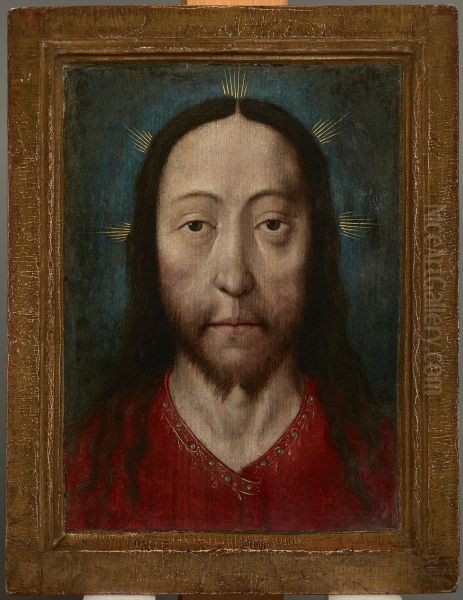
For a considerable time, Albrecht Bouts was somewhat eclipsed by the fame of his father. Early art historical accounts often focused on Dieric Bouts the Elder, and Albrecht's contributions were sometimes conflated with the broader workshop output or seen as merely derivative. However, modern scholarship, beginning in the late 19th and accelerating in the 20th and 21st centuries, has done much to re-evaluate Albrecht's distinct artistic identity and his significant role in the art of Leuven and the broader Netherlandish tradition.
Art historians like Max J. Friedländer, in his comprehensive survey of Early Netherlandish painting, helped to delineate Albrecht's oeuvre and highlight his specific stylistic traits. Subsequent research and exhibitions, including focused studies on the Bouts dynasty, have further clarified his position. He is now recognized not just as the son of a famous father, but as a master in his own right, an artist who skillfully adapted his heritage to meet the evolving devotional needs of his time.
His workshop's prolific output of small-scale devotional panels played a crucial role in popularizing certain iconographic types and in fostering the culture of private piety that was so characteristic of the late medieval and early Renaissance periods in Northern Europe. These works, with their direct emotional appeal and meticulous craftsmanship, resonated deeply with contemporary viewers and continue to engage audiences today. The rediscovery and reattribution of works like his potential self-portrait have added further layers to our understanding of the artist.
Albrecht Bouts stands as a key figure in the transition from the high point of Early Netherlandish art in the 15th century, exemplified by artists like Jan van Eyck, Rogier van der Weyden, and his own father, to the more diverse artistic landscape of the 16th century. While perhaps not as revolutionary an innovator as some of his predecessors or contemporaries like Hieronymus Bosch, his strength lay in his ability to synthesize tradition with a personal vision, creating works of enduring spiritual power and artistic merit. His long career ensured the continuation of a significant artistic tradition in Leuven for over half a century, making him an indispensable link in the chain of Netherlandish painting.
Conclusion
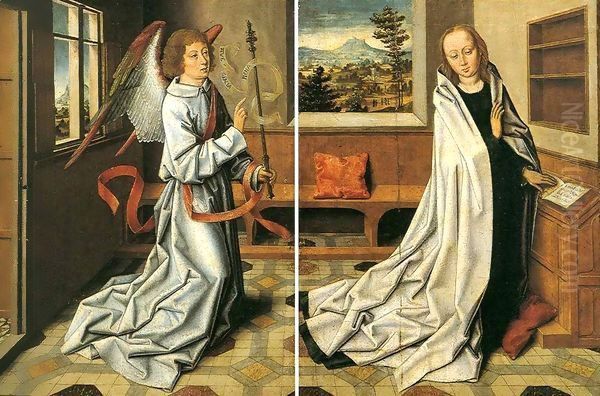
Albrecht Bouts was a pivotal artist who successfully navigated the legacy of a famous father to forge his own distinct path. His workshop in Leuven became a center for the production of devotional art that catered to the spiritual aspirations of his time, particularly the Devotio Moderna. Through his intense color palette, meticulous detail, and profound emotional engagement with religious subjects, Bouts created a body of work that, while rooted in the late Gothic tradition, possesses a timeless appeal. His contributions to the iconography of Christ's suffering and the Virgin's compassion, and his role in the dissemination of devotional imagery, secure his place as an important master of Early Netherlandish painting, whose works continue to be studied and admired for their artistic quality and spiritual depth.